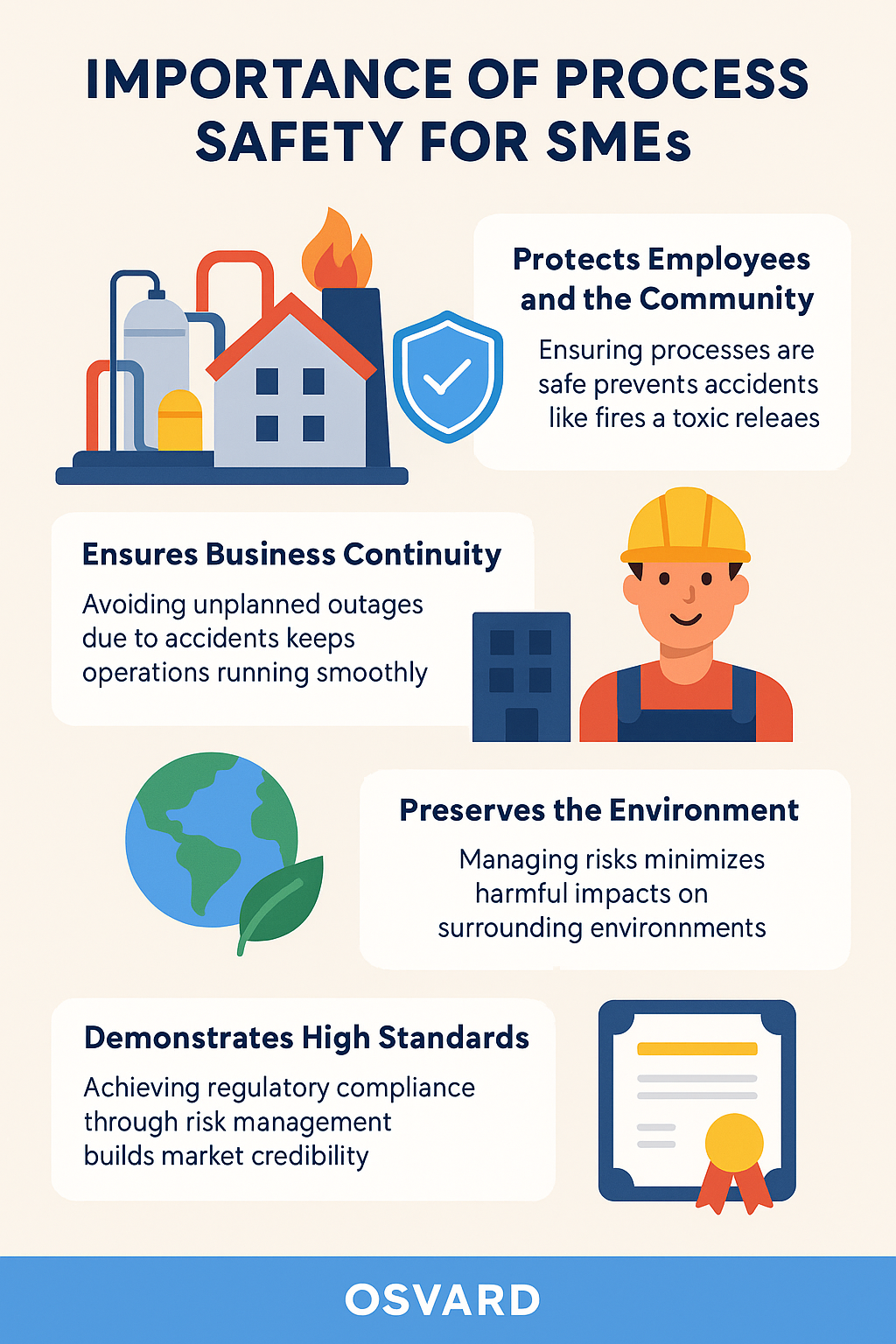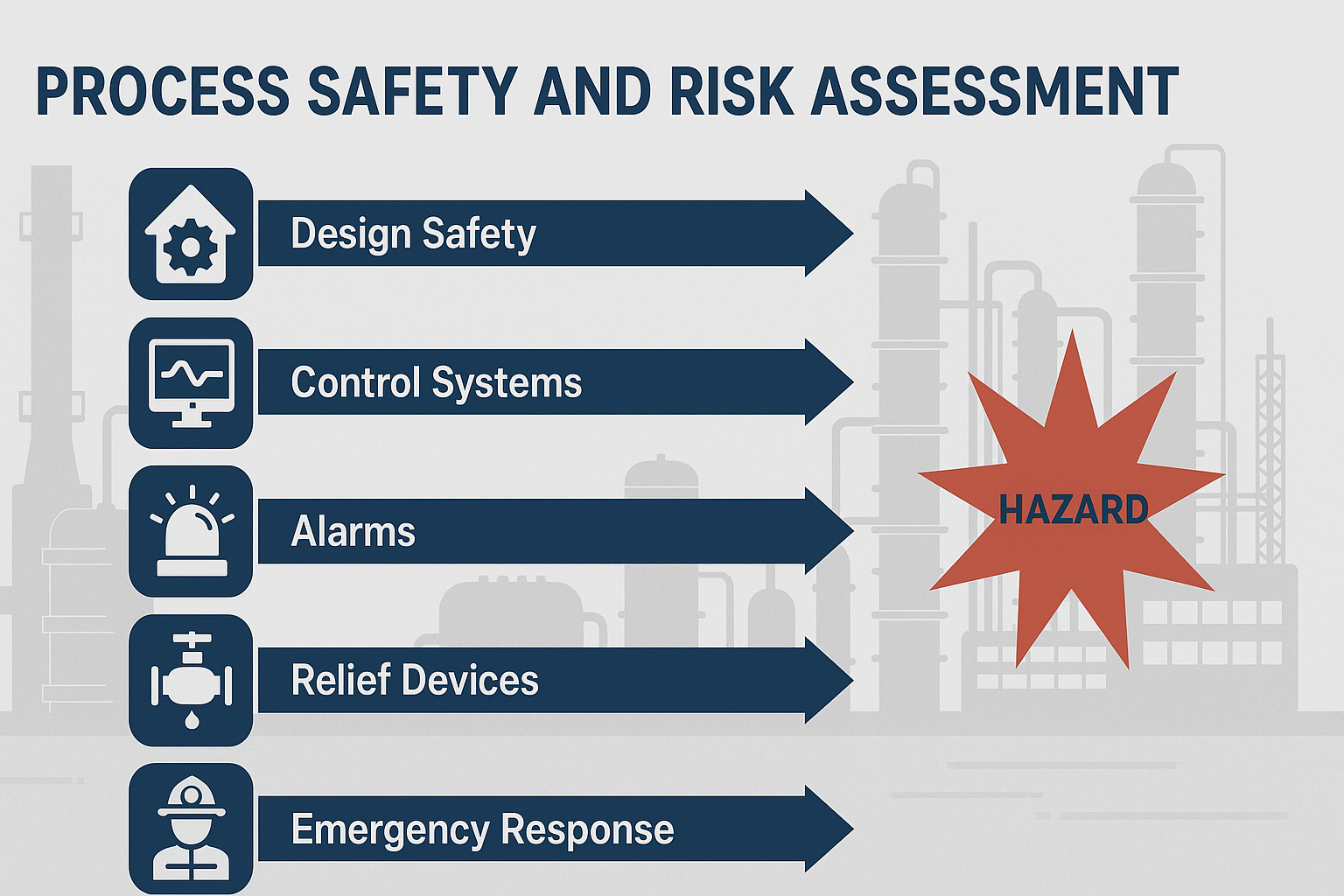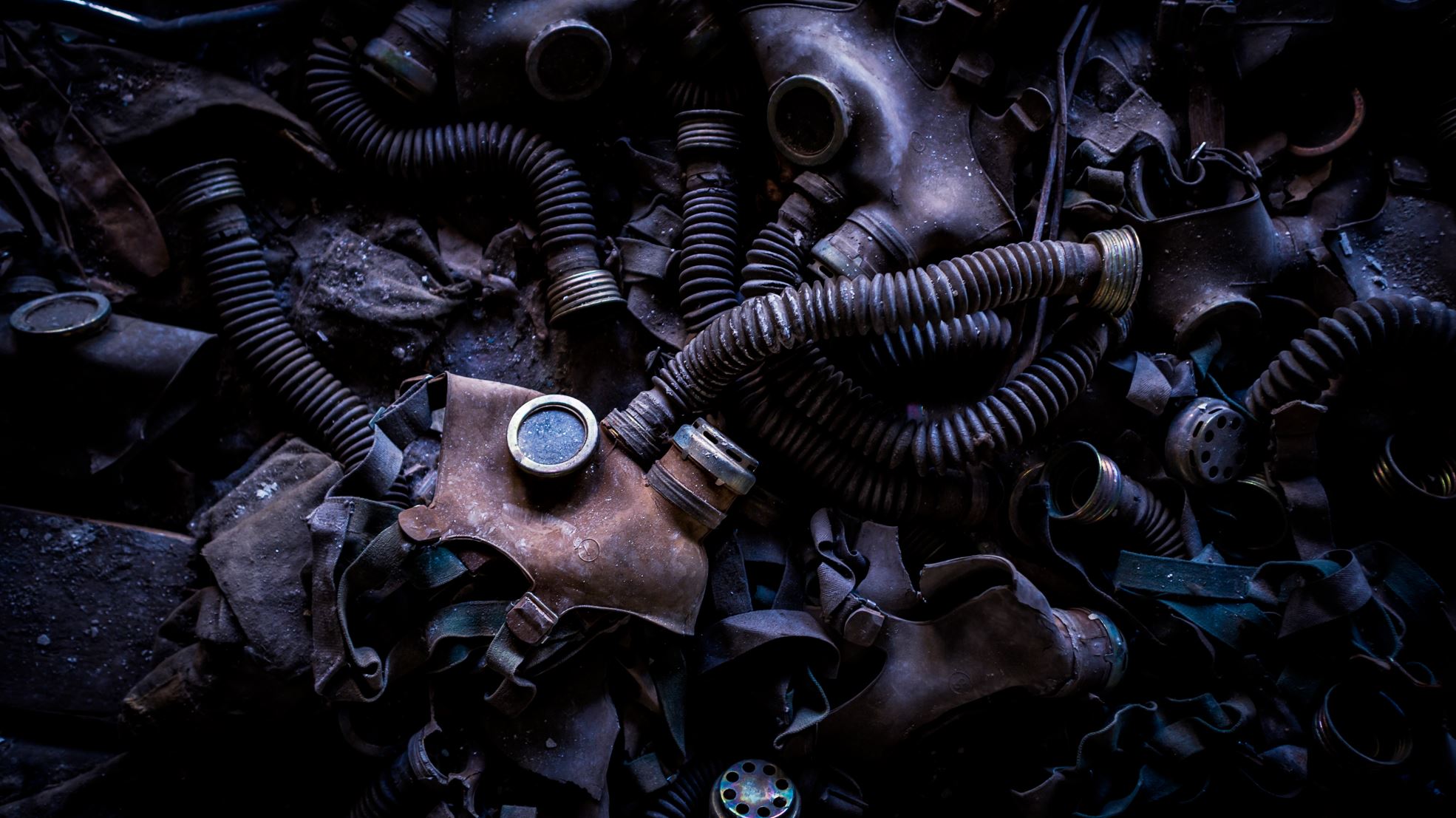In high-hazard industries such as chemicals, petrochemicals, and pharmaceuticals, process safety and risk assessment are critical practices to prevent accidents and protect both people and assets. Process safety is a specialized discipline that focuses on controlling the hazards associated with handling and processing hazardous materials – aiming to prevent catastrophic incidents like fires, explosions, or toxic releasesworksafebc.com.
It is distinct from personal or occupational safety; process safety takes a proactive, engineering-based approach to manage the risk of major accidents by ensuring that processes are well-designed and operate within safe limitsworksafebc.com. Essentially, process safety management involves identifying potential failure scenarios in industrial processes and putting in place layers of protection to mitigate those risks.
A risk assessment is the systematic process of identifying potential hazards, analyzing what could go wrong, and evaluating the likelihood and severity of adverse outcomes. In the context of process safety, risk assessments delve into scenarios such as chemical reactor runaways, pipeline leaks, high-pressure vessel failures, or any event that could lead to a loss of containment.
According to process safety guidelines, this practice is the cornerstone of effective safety management: It involves estimating the probability and consequences of incidents to focus resources on the most significant riskslinkedin.com. For example, a risk assessment might analyze a storage tank area and determine the chance of an overfill and spillage, then quantify the potential impact (fire, environmental contamination, etc.). By understanding these risks, companies can prioritize safety investments (like installing additional alarms or containment dikes) where they matter most.
In many countries and regions, regulatory compliance is a key driver for process safety and risk assessment. Authorities require companies dealing with hazardous materials to conduct regular Process Hazard Analyses (PHAs) and implement robust risk management programs. Failure to comply can result in severe penalties or even shutdown of facilities.
But beyond compliance, embracing process safety is simply good business practice – major accidents not only endanger lives but also cause lengthy shutdowns, legal liabilities, and damage to reputation that can be irreparable for an enterprise.
Major chemical accidents have historically impacted large corporations, but small and medium enterprises are not immune to process safety risks. In fact, SMEs often face the challenge of limited resources and smaller safety teams, which makes a structured approach to risk assessment even more crucial. A single incident (such as a fire or toxic release) at a smaller chemical plant or manufacturing site can be devastating, potentially shutting down operations permanently. Therefore, building a strong process safety foundation is a wise investment for companies of all sizes.
Investing in process safety and risk assessments yields multiple benefits: it protects employees and the community, ensures business continuity, and preserves the environment. Importantly, it also fosters a culture of safety and responsibility within the organization.
As one safety professional emphasizes, making sure your business processes are safe and that staff are prepared for potential dangers is key to any operation – risk assessments clarify these dangers and how to handle themeadcorporate.com. Companies that routinely perform risk assessments tend to experience fewer unplanned outages and incidents, which directly correlates with better productivity.
In other words, safe operations and efficient operations go hand in hand. There is also a financial motivation: unplanned downtime due to accidents can be extremely costly. Studies indicate that unscheduled downtime can sap as much as 11% of annual revenue for large manufacturing companiesismworld.org (and SMEs likewise suffer heavy losses when production is halted unexpectedly).
By preventing accidents through robust risk management, companies avoid these devastating costs and maintain steady production.
From a regulatory standpoint, process safety is increasingly mandated. In Thailand and other Asian countries, governments have been strengthening regulations on the management of hazardous processes in line with global standards. For example, operators of chemical plants may need to demonstrate compliance with frameworks similar to OSHA’s Process Safety Management (PSM) or the EU’s Seveso directive.
Regular risk assessments (like HAZOP studies or Quantitative Risk Assessments) and the implementation of risk mitigation measures are typically required under such regulations. SMEs that proactively address process safety can not only avoid regulatory penalties but often gain a market advantage – being able to show customers and partners that they adhere to high safety standards.

OSVARD provides end-to-end consulting services to help clients establish and maintain strong process safety programs. Our services include:
Process Hazard Analysis (PHA) – We facilitate thorough PHAs for new or existing processes, using methodologies such as Hazard and Operability (HAZOP) studies, What-If analysis, or Failure Mode and Effects Analysis (FMEA). In a HAZOP, for example, OSVARD assembles a multi-disciplinary team (operations, engineering, maintenance personnel) and systematically examines the process Piping and Instrumentation Diagrams (P&IDs) to identify how deviations (like higher temperature, higher pressure, flow changes, etc.) could lead to hazardous consequences.
Our experienced facilitators ensure that the discussion is rigorous and that for each identified hazard, the team evaluates existing safeguards and recommends additional risk controls if needed. The output is a detailed log of potential issues and actionable recommendations to improve safety.
Quantitative Risk Assessment (QRA) – For scenarios that require detailed quantification (such as understanding the offsite risk of a toxic gas release or explosion), OSVARD conducts QRAs. We use industry-standard software tools and models to estimate event frequencies and impact zones. For instance, we can model the dispersion of a gas leak and determine the concentration at various distances, or estimate overpressure distances for a possible vessel rupture. These analyses allow clients to visualize worst-case and typical-case outcomes, often in the form of risk contour plots.
We compare the results against risk acceptance criteria (often provided by regulations or company policy) to identify if any scenario exceeds tolerable risk levels. If so, OSVARD will recommend measures like inventory reduction, additional safety instrumented functions, or greater separation distances to reduce risk to acceptable levels.
Safety Management System Development – Beyond assessing individual hazards, OSVARD helps clients build a holistic Process Safety Management (PSM) system. This may involve creating or improving elements such as: operating procedures, maintenance and mechanical integrity programs, management of change (MOC) processes, emergency response plans, and training programs. Our consultants can perform a gap analysis of the client’s current safety programs against recognized frameworks (for example, OSHA’s 14 elements of PSM or CCPS Risk Based Process Safety guidelines) and then assist in filling the gaps.
This could include writing procedures for how to conduct a startup safely, setting up a permit-to-work system for hot work, or establishing key performance indicators for process safety (like tracking near-misses or safety critical equipment inspection overdue rates). By strengthening these systems, the organization ensures that safety is managed consistently, not left to ad-hoc efforts.
Compliance Audits and Incident Investigation – OSVARD’s safety experts also offer third-party compliance audits as described earlier, specifically focusing on process safety program adherence. We can audit a facility’s PSM program to verify that PHAs are up to date, operating personnel are knowledgeable about the hazards, critical alarms and interlocks are tested, and so on.
If a client has experienced a process incident or a significant near-miss, OSVARD can lead or support an incident investigation to determine root causes (using methods like Tripod Beta or TapRooT analysis) and recommend effective corrective actions. Our independent perspective often helps in identifying systemic issues that internal teams might overlook.
Training and Culture Building – Recognizing that true process safety excellence requires a culture of safety, OSVARD provides training workshops and mentoring. We train client teams on hazard recognition, safe operating principles, and emergency response. For instance, we can run tabletop drills simulating an emergency scenario to test and improve the preparedness of staff.
By involving the workforce and management in these exercises, we help cultivate a risk-aware culture where everyone understands the hazards of their process and their role in managing them.
OSVARD employs a rigorous methodology grounded in both international best practices and local industry knowledge. Our team stays updated with standards like API, NFPA, IEC 61511 (functional safety for SIS), etc., ensuring our advice is compliant with the latest safety codes. We also leverage advanced tools during risk assessments:
Simulation and Modeling: We use software to simulate complex processes and potential upset conditions. For example, dynamic simulation can predict how a reactor behaves if a cooling failure occurs, helping in designing the relief system and control strategies. Consequence modeling tools allow us to estimate gas dispersion or thermal radiation from fires quantitatively, which is vital for layout decisions and emergency planning.
Layer of Protection Analysis (LOPA): After identifying hazards in a qualitative study, OSVARD can perform LOPA to evaluate if existing Independent Protection Layers (IPLs) are sufficient. We assign risk reduction credit to things like instrumented safety systems, relief devices, dikes, or operator response, and calculate the residual risk. This approach helps justify if a hazard scenario needs an extra layer of protection (for instance, whether to add a high-integrity shutdown system on a reactor feed). It’s a cost-effective way to ensure neither under- nor over-design of safeguards.
Safety Integrity Level (SIL) Verification: For clients implementing Safety Instrumented Systems (SIS) such as emergency shutdowns or interlocks, OSVARD provides SIL selection and verification services. We determine the required reliability (SIL level) for each safety instrumented function based on risk targets, and then verify through calculation that the chosen instruments/architecture meet that reliability. This involves calculations of failure probabilities and considering redundancy, per standards like IEC 61508/61511.
Risk Ranking and Action Prioritization: Given that resources are finite, OSVARD emphasizes prioritizing the risk reduction actions. During our assessments, we typically rank identified risks by a risk matrix (likelihood vs severity). High-risk items (e.g., a scenario with both high likelihood and high consequence) are highlighted for immediate attention, whereas lower risk items are scheduled appropriately. This ensures that our clients get a clear roadmap focusing first on the most critical safety improvements.
Through each step, we maintain close communication with client personnel. We believe that risk assessment is not a one-time report, but an ongoing process that clients should own. So we often conduct training alongside studies, and we encourage client team members to actively participate in all analyses. This knowledge transfer ensures the recommendations are practical and that the client’s team is capable of sustaining process safety efforts long-term.
OSVARD’s process safety and risk assessment services are applied across various segments of the process industry:
Chemical and Petrochemical Plants: We have assisted manufacturers of specialty chemicals, fertilizers, petrochemicals, and plastics with comprehensive risk management. For instance, an OSVARD-led HAZOP at a batch specialty chemical plant helped the client identify a risk of thermal runaway in a reactor when a cooling valve fails. We recommended installing a secondary cooling water feed and an automated reactor kill system.
These recommendations were implemented, significantly lowering the risk of a runaway reaction incident. In a refinery setting, our team performed a QRA to assess the impact of a possible gas cloud explosion in the gas processing unit. The results guided the refinery to rearrange some equipment and strengthen blast walls, improving the overall facility layout safety.
Pharmaceutical and Biotech Facilities: Such facilities handle solvents and reactive substances on a smaller scale but often in urban locations. OSVARD has conducted solvent vapor explosion risk assessments in pharmaceutical formulation plants and recommended ventilation improvements and vapor detection systems to reduce explosion risk. We also help pharma clients ensure compliance with both safety and GMP (Good Manufacturing Practice) requirements, finding the balance between product safety and process safety.
Food and Beverage Industry: Industries like food processing may use ammonia refrigeration or other chemicals where process safety is relevant. OSVARD performed a risk assessment for an ammonia refrigeration system at a food processing SME, identifying scenarios for ammonia leaks. Our team proposed enhanced ammonia detection and emergency ventilation systems, as well as operator training, to mitigate the toxic release risk. This not only brought the facility in line with safety regulations but also alleviated community concerns about the facility’s safety.
Oil and Gas Operations: In pipeline terminals or small gas processing facilities, OSVARD’s risk assessment can address flammable gas hazards. For example, for a client operating a fuel storage depot, we carried out a fire and explosion risk analysis. We examined tank overfill scenarios, jet fires from pipe leaks, and pool fires. The study informed an upgrade of the depot’s firefighting systems and the installation of advanced tank overfill prevention instruments. Subsequently, the client demonstrated to regulators and insurers that risk levels were reduced, leading to continued license to operate and even lower insurance premiums due to the improved safety measures.
General Manufacturing (with hazardous substances): Even factories that are not primarily chemical plants often have some hazardous processes (paint lines with flammable solvents, plating operations with toxic gases, etc.). OSVARD’s tailored risk assessments for such cases help these manufacturers control the hazards peripheral to their main production. For instance, at a metal fabrication plant with an acetylene cylinder storage, we evaluated the explosion risks and recommended site modifications including better separation and protective barriers.
Across all these examples, a common thread is that OSVARD’s involvement brought a systematic, expert perspective to safety challenges that the companies faced. Our clients often note that after implementing our recommendations, they not only feel more secure but also observe indirect benefits – smoother operations and even improved morale, as employees know their safety is prioritized.
Importantly, being proactive about process safety strengthens an organization’s reputation; clients, investors, and partners prefer to engage with companies that manage risk responsibly.
In conclusion, OSVARD’s Process Safety and Risk Assessment services help companies operate with confidence – safe, compliant, and prepared for growth. By identifying hazards early and managing risks effectively, our clients protect their workforce, their community, and their bottom line from the potentially devastating effects of industrial accidents.













